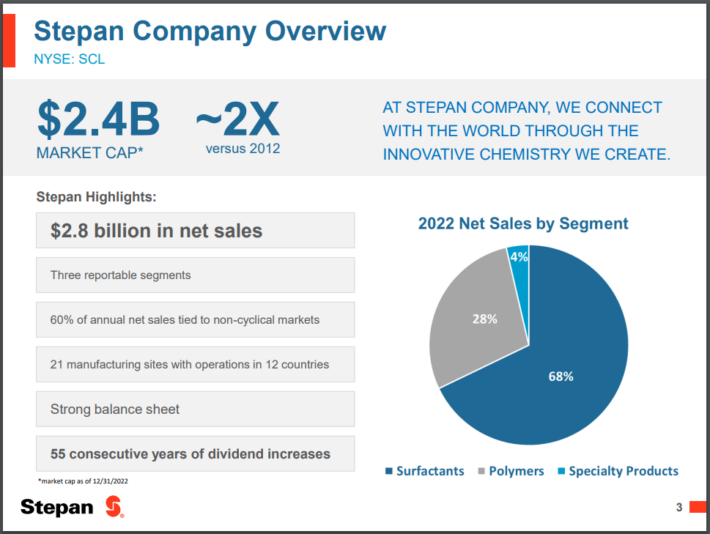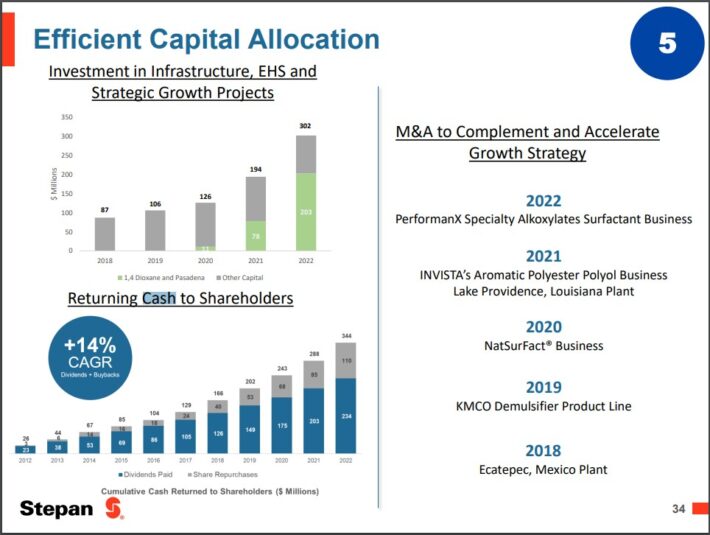Updated on September 11th, 2023 by Nate Parsh
Stepan Company (SCL) has a dividend track record that few companies can rival. The company currently sports a streak of 55 consecutive years of increasing dividends, making it one of just 50 stocks in the entire stock market with a dividend increase streak above 50 years.
That puts the company among the elite Dividend Kings, a small group of stocks that increased their payouts for at least 50 consecutive years. You can see the full list of all 50 Dividend Kings here.
We have created a full list of all 50 Dividend Kings, along with important financial metrics such as price-to-earnings ratios and dividend yields. You can access the spreadsheet by clicking on the link below:
Dividend Kings are the “best of the best” when it comes to rewarding shareholders with cash returns, and raising their dividend payouts every year. This article will discuss Stepan’s dividend and valuation outlook.
Business Overview
Stepan traces its origins back to 1932 when it was founded by 23-year old Alfred C. Stepan Jr., and was known at the time as Chemical Distributors. The fledgling enterprise’s first product was a chemical that controlled road dust on Illinois’ country thoroughfares, sold from a rented desk at Chicago’s North Pier Terminal. These humble beginnings were the start of what became a multi-billion chemical powerhouse.
The company is still headquartered in Illinois and manufactures basic and intermediate chemicals, including surfactants, specialty products, germicidal and fabric softening quaternaries, phthalic anhydride, polyurethane polyols and special ingredients for the food, supplement, and pharmaceutical markets.
It expanded from that desk at the North Pier Terminal to a truly global reach with its 21 manufacturing sites in 12 countries throughout North and South America, Asia, and Europe. Stepan also boasts global R&D centers, a worldwide distribution network and a broad portfolio of products to meet a diverse group of customer needs.
Stepan is organized into three distinct business lines: surfactants, polymers, and specialty products. These businesses serve a wide variety of end markets, meaning that Stepan is not beholden to a handful of industries; an important trait during an economic downturn.

Source: Investor presentation
The surfactants business is Stepan’s largest by revenue, accounting for ~68% of total sales in the most recent quarter. A surfactant is an organic compound that contains both water-soluble and water-insoluble components. Surfactants are key ingredients in consumer and industrial cleaning compounds such as detergents, cleansing agents, emulsifiers, foaming or defoaming agents, viscosity builders, degreasers, and others.
Stepan offers a broad range of surfactant chemicals and creates custom surfactants and formulated blends to meet unique customer demands. These surfactants are used in a wide variety of applications such as a foaming agent for shampoo, agents used in oil recovery and emulsifiers for agricultural insecticides.
The polymers business is Stepan’s second-largest by revenue, producing about 28% of the company’s total. The polymers division is further broken down into three segments: polyester polyols, powder coating resins, and phthalic anhydride. Polyester polyols are used in a wide variety of both polyurethane and polyisocyanurate applications. Stepan produces a full range of aromatic and aliphatic polyester polyols for use in rigid foams, as well as many coatings, adhesives, sealants, and elastomers applications.
Polyester resins are designed with either hydroxyl or carboxyl functionality and combine with various curatives to form durable, attractive, environmentally friendly powder coatings. The company’s RUCOTE resins can enhance the quality, performance, and visual appeal of finishes on a wide variety of products.
Phthalic anhydride is an important part of Stepan’s polymers division. In addition to being used in polyester polyol chemistry, phthalic anhydride is a key raw material for plasticizers and unsaturated polyester resins.
The third division, specialty chemicals, is Stepan’s smallest by revenue, producing only about 4% of the company’s total. The segment produces science-based nutritional oils used in the food, nutrition, and pharmaceutical industries. Its products are naturally derived ingredients that provide specific nutritional benefits in end markets like dietary supplements, beverages, nutritional powders, infant nutrition, and weight management.
Growth Prospects
Stepan reported second-quarter earnings on July 26th, 2023, with results coming in below estimates on both the top and bottom lines. Net income came to $12.7 million, or $0.55 per share. Both results are down significantly from $52.1 million and $2.26 per share, respectively, in the year-ago period. On an adjusted basis, net income was $12.1 million, or $0.53 per share.
Total volumes were down 19% year-over-year. Surfactant operating income was $15 million, down from $48.2 million in the year-ago period. The decrease was due to lower sales volumes, which were down 15% from the prior year.
Polymer operating income was $16 million, down from a record $33.9 million for the same period last year. The decline was due primarily to a 29% drop in global volumes.
Global demand has fallen for both businesses, leading to industry-wide destocking. Quarterly results led to massive reductions in earnings estimates for 2023. We forecast earnings-per-share of $2.80 for this year, down from $6.65 in 2022.
There are some positives working in Stepan’s favor. The company’s stated growth strategy includes R&D that develops a continuous stream of value-added applications, developing new processes for current products as well as refining existing processes. It also makes targeted acquisitions from time to time when appropriate, picking up manufacturing capacity or some other strategic advantage from its acquisitions.
It grows further by establishing manufacturing locations and sales offices where its customers are in the world, meaning it can more efficiently and effectively serve those varied customers.
Finally, it seeks to grow through strategic alliances via joint ventures where Stepan acts as a technical expert to complement the resources of a local partner with resources in the area. This comprehensive growth strategy has worked for Stepan in the past and while it is not a true growth stock, over time it has produced meaningful revenue expansion using these strategies.
Stepan’s growth has been somewhat lumpy in the past, but, overall, the company has produced respectable growth over the long-term. We project earnings growth of 7% annually over the next five years, though we note that growth may not occur in a linear fashion.
Competitive Advantages & Recession Performance
Stepan’s competitive advantages include its customer base and end market diversity, its global supply chain and distribution network, as well as its technical expertise. Stepan is a true market leader in its niche and this has fueled its growth in the past 80+ years.
Stepan’s customers are extremely diverse, including end markets like agricultural products, construction, dietary supplements, cleaning products, personal care, laundry, oilfield services, pharmaceuticals and many more. There are not many businesses in the world that serve such diverse end markets, and that offers Stepan exposure to lots of different industries. This creates lots of opportunities for growth as well as recession resistance.
In addition, the company operates around the world. This allows it to have technical experts and sales professionals on the ground near its customers, developing products and solving problems more quickly and efficiently than if it were centralized here in the U.S. Adding in its vertical supply chain – which improves margins and reduces supplier risk – Stepan’s global footprint is a sizable asset.
Stepan’s products are also needs and not wants, meaning that during recessions, the company fares very well. Indeed, during the Great Recession, it performed tremendously well; Stepan’s earnings-per-share during and after the Great Recession are below:
- 2007 earnings-per-share of $0.75
- 2008 earnings-per-share of $1.20 (increase of 60%)
- 2009 earnings-per-share of $2.92 (increase of 143%)
- 2010 earnings-per-share of $2.95 (increase of 1.0%)
Revenue moved higher each year during this period except for 2009, but a tremendous amount of margin improvement during this period saw Stepan drastically increase its earnings despite the economic malaise that had the world in its grips. Operating margins were just 1.4%, in 2006 but peaked at 8.2% in 2009, driving the earnings growth Stepan enjoyed during this period.
Stepan is a very recession-resistant business and that is one advantage it provides to shareholders. The company again proved its resilience in 2020, as it continued to raise its dividend even in the challenging economic conditions caused by the pandemic.
Valuation & Expected Returns
With the current share price at ~$78, Stepan trades at a price-to-earnings ratio of 27.9, well above our estimate of fair value at 17 times earnings.
Stepan stock appears to be extremely overvalued right now, in our view. If the P/E multiple contracts from nearly 28 to 17 in the next five years, valuation would reduce annual returns by 9.4% per year.
The company does use its capital to further its business through acquisitions, but Stepan, as a Dividend King, has been returning cash to shareholders for more than a half-century. Its recent growth in capital returns has been impressive.

Source: Investor Presentation
In the past 11 years, Stepan managed to boost its total annual capital returns — buybacks and dividends — by 14%. That’s very impressive and while we don’t think that sort of growth rate can be sustained for the long-term, the dividend appears safe even after the reduction in earnings estimates as the expected payout ratio for this year is 52%.
While the yield isn’t very impressive at just 1.9%, investors can sleep well at night knowing their payout is safe, and will likely continue to be raised for decades to come.
The 1.9% yield and the 7% projected annual EPS growth are likely to be more than offset by ahigh single-digit headwind from multiple compression, resulting in projected loss of -0.5% annually over the next five years. Stepan earns a sell recommendation due to projected returns.
Final Thoughts
Due to its low dividend yield, Stepan doesn’t qualify as a high-income stock despite its Dividend King status. However, the company raises its dividend each and every year.
That said, shares look overvalued given our expectations for earnings results for 2023. Stepan is a leader in its niche and has demonstrated that it is a strong business long-term with a growing dividend, but we believe investors are best served waiting for a better entry point.
The following articles contain stocks with very long dividend or corporate histories, ripe for selection for dividend growth investors:
Thanks for reading this article. Please send any feedback, corrections, or questions to [email protected].















